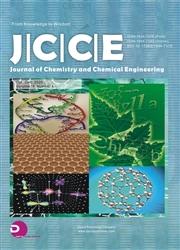Equilibrium and Kinetic Studies of Reactive Black 8 Adsorption onto Crosslinked Chitosan Beads
引用次数: 0
Abstract
Environmental pollution problems by the discharge of effluent containing various contaminations from textile, paper and paint industries have become a serious issue in recent years. Dye removal from wastewater has received considerable attention for several adsorbents and several classes of dye. Reactive black 8 is an environmentally hazardous dye and most applicable in textile industries. Chitosan is a non-toxic, biodegradable and biocompatible and acts as an efficient adsorbent because of the amino functional groups. In the present work, the crosslinked chitosan beads were synthesized by using glutaraldehyde as a crosslinker and the adsorptive removal of reactive black 8 by the beads from an aqueous solution was investigated. The effect of contact time and initial dye concentration was evaluated. The adsorbent dosage was retained as 1 g/L and initial dye concentration values were varied from 30 to 150 mg/L. Equilibrium isotherms were analysed by Langmuir, Freundlich, Dubnin–Radushkevich, and Temkin isotherm. Freundlich isotherm model was found fit effectively for the reactive black 8 adsorptions. Kinetic adsorption data were evaluated using the pseudo-first-order kinetic model, the pseudo-second-order kinetic model and the intraparticle diffusion model. The adsorption followed pseudo second order kinetics. Overall, this study indicates chitosan beads as an efficient, eco-friendly and low-cost adsorbent for the removal of reactive black 8 dye from aqueous solutions.交联壳聚糖微球吸附活性黑8的平衡及动力学研究
近年来,纺织、造纸和油漆行业排放的含有各种污染物的废水造成的环境污染问题已成为一个严重的问题。由于几种吸附剂和几种染料,从废水中去除染料受到了相当大的关注。活性黑8是一种对环境有害的染料,最适用于纺织工业。壳聚糖是一种无毒、可生物降解和生物相容性强的吸附剂,具有氨基官能团。本工作以戊二醛为交联剂合成了交联壳聚糖微珠,并研究了微珠对水溶液中活性黑8的吸附去除作用。评价了接触时间和初始染料浓度的影响。吸附剂剂量保持为1g/L,初始染料浓度值在30至150mg/L之间变化。用Langmuir、Freundlich、Dubnin–Radushkevich和Temkin等温线分析了平衡等温线。Freundlich等温线模型适用于活性黑8的吸附。动力学吸附数据使用伪一阶动力学模型、伪二阶动力学模型和颗粒内扩散模型进行评估。吸附遵循准二阶动力学。总之,本研究表明壳聚糖珠是一种高效、环保、低成本的吸附剂,可用于从水溶液中去除活性黑8染料。
本文章由计算机程序翻译,如有差异,请以英文原文为准。
求助全文
约1分钟内获得全文
求助全文

 求助内容:
求助内容: 应助结果提醒方式:
应助结果提醒方式:


